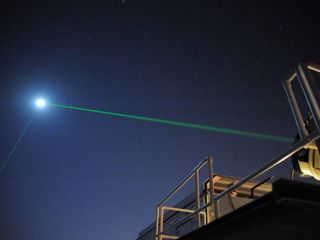Οι αστρονόμοι ''αντανάκλασαν'' μία ακτίνα λέιζερ σε ένα διαστημικό σκάφος που περιστρέφεται γύρω από το φεγγάρι. Astronomers bounced a laser off a spacecraft whirling around the moon.
Αυτό είναι ένα ακριβές πλάνο λέιζερ.

.space.com - 7spymania.com Για πρώτη φορά, οι επιστήμονες αναπήδησαν με επιτυχία ένα λέιζερ από έναν καθρέφτη που συνδέεται με ένα διαστημικό σκάφος που περιστρέφεται γύρω από το φεγγάρι.
Η αναπήδηση των λέιζερ από τους καθρέφτες στην σεληνιακή επιφάνεια είναι ένα παλιό τέχνασμα. Οι αστροναύτες περπατούσαν στο φεγγάρι πρώτα αριστερά πίσω από τους ανακλαστήρες το 1969. Και από τότε, οι ερευνητές αναπήδησαν τα λέιζερ από αυτούς τους ανακλαστήρες για να κάνουν ακριβείς μετρήσεις της απόστασης μεταξύ του φεγγαριού και της Γης, χρησιμοποιώντας την ταχύτητα του φωτός και το χρόνο που χρειάζεται για τη δέσμη λέιζερ. να επιστρέψει στη Γη.
Αλλά το χτύπημα ενός λέιζερ σε τροχιά γύρω από το φεγγάρι είναι πολύ πιο δύσκολο έργο. Το Lunar Reconnaissance Orbiter (LRO) περιστρέφεται γύρω από το φεγγάρι με έναν καθρέφτη στην πλάτη του από το 2009. Αλλά πέρασε σχεδόν μια δεκαετία χωρίς μια επιτυχημένη αναπήδηση με λέιζερ. Σε μια δημοσίευση στις 6 Αυγούστου στο περιοδικό Earth, Planets and Space, μια ομάδα ερευνητών ανέφερε την πρώτη επιτυχημένη επαφή με λέιζερ: Δύο φορές στις 4 Σεπτεμβρίου 2018 και δύο φορές ξανά μεταξύ 23 Αυγούστου και 24 Αυγούστου 2019, τεχνικοί στο Ο σταθμός Lunar Laser Ranging (LLR) στο Grasse της Γαλλίας, πυροδότησε εκρήξεις λέιζερ στο LRO και είδε το φως να επιστρέφει 2,5 δευτερόλεπτα αργότερα.
Για να βεβαιωθείτε ότι το φως που αναπηδά από το LRO επιστρέφει προς την κατεύθυνση από την οποία προήλθε, ο καθρέφτης στην πλάτη του είναι πιο περίπλοκος από αυτόν στο μπάνιο σας. Όπως και οι παλαιότεροι καθρέφτες στην σεληνιακή επιφάνεια, είναι ένας «γωνιακός κύβος» - μια σειρά τρισδιάστατων καθρεπτών, καθένας κυριολεκτικά διαμορφωμένος σαν το εσωτερικό μιας γωνίας ενός κύβου. Όταν ένα λέιζερ το χτυπά, το φως αναπηδά τρεις φορές πριν η γεωμετρία του καθρέφτη το επιστρέψει στην ακριβή κατεύθυνση από την οποία προήλθε.
For the first time, scientists have successfully bounced a laser off a mirror that's attached to a spacecraft whirling around the moon.
Bouncing lasers off mirrors on the lunar surface is an old trick. Astronauts walking on the moon first left reflectors behind in 1969. And since then, researchers have bounced lasers off those reflectors to make precise measurements of the distance between the moon and Earth, using the speed of light and the time it takes for the laser beam to return to Earth.
But hitting a laser in orbit around the moon is a much trickier task. The Lunar Reconnaissance Orbiter (LRO) has orbited the moon with a mirror on its back since 2009. But nearly a decade went by without a single successful laser bounce. In an Aug. 6 paper in the journal Earth, Planets and Space, a team of researchers report the first successful laser contact: Twice on Sept. 4, 2018 and twice again between Aug. 23 and Aug. 24, 2019, technicians at the Lunar Laser Ranging (LLR) station in Grasse, France, shot laser bursts at the LRO and saw the light return 2.5 seconds later.
Related: Why does the moon shine?
To make sure that the light bouncing off the LRO returns in the direction from which it came, the mirror on its back is more complicated than the one in your bathroom. Like the older mirrors on the lunar surface, it's a "corner cube" — a series of three-dimensional mirrors, each literally shaped like the inside of one corner of a cube. When a laser hits it, the light bounces three times before the geometry of the mirror returns it in the precise direction from which it came.

Η παρακολούθηση της κίνησης του LRO με την πάροδο του χρόνου είναι από μόνη της ένα ενδιαφέρον επιστημονικό έργο. Όμως, έγραψαν οι ερευνητές, αυτές οι τέσσερις επιτυχημένες επαφές λέιζερ δεν προσφέρουν αρκετά δεδομένα για την παρακολούθηση αυτής της κίνησης. Το LRO εξακολουθεί να κινείται πολύ γρήγορα και πολύ απρόβλεπτα για να χτυπήσει αξιόπιστα με ένα λέιζερ και και οι τέσσερις επαφές έγιναν κάτω από αυτό που οι ερευνητές περιέγραψαν ως ιδανικές συνθήκες. Το φεγγάρι, το LRO και η Γαλλία ήταν όλα ευθυγραμμισμένα τέλεια για να βελτιώσουν τις πιθανότητες επαφής με λέιζερ.
Tracking the movement of the LRO over time is an interesting scientific project in its own right. But, the researchers wrote, these four successful laser contacts don't offer enough data to track that movement. The LRO is still moving too fast and too unpredictably to reliably hit with a laser, and all four contacts were made under what the researchers described as ideal conditions. The moon, LRO and France were all lined up perfectly to improve the odds of laser contact.

Μακροπρόθεσμα, οι μελέτες του καθρέφτη LRO θα μπορούσαν να βοηθήσουν στην επίλυση ενός δυσνόητου προβλήματος που επηρεάζει τους καθρέφτες που αφήνονται στην επιφάνεια του σεληνής. Όλοι αυτοί οι καθρέφτες έχουν γίνει λιγότερο ανακλαστικοί με την πάροδο του χρόνου και οι ερευνητές δεν είναι σίγουροι γιατί. Αλλά αυτή η χαμένη ποιότητα καθιστά τις ακριβείς μετρήσεις πιο δύσκολες. Το ζήτημα θα μπορούσε να είναι ότι η μακροχρόνια έκθεση στην ηλιακή ακτινοβολία αποδυναμώνει τους καθρέφτες. Σε αυτήν την περίπτωση, ο καθρέφτης του LRO θα πρέπει να εξασθενεί με την πάροδο του χρόνου με τον ίδιο ρυθμό. Εναλλακτικά, η σεληνιακή σκόνη ή η αχνή ομίχλη από τη λεπτή ατμόσφαιρα του φεγγαριού θα μπορούσαν να κρύβουν τους καθρέφτες, έγραψαν οι ερευνητές. Σε αυτήν την περίπτωση, η ανακλαστικότητα του LRO θα πρέπει να παραμείνει λίγο πολύ αμετάβλητη με την πάροδο του χρόνου σε τροχιά, ακόμη και όταν ο καθρέφτης της επιφάνειας υποβαθμίζεται.
Over the long-term, studies of the LRO mirror could help resolve a tricky problem impacting the mirrors left on the lunar surface. All of those mirrors have become less reflective over time, and researchers aren't sure why. But that lost quality is making precise measurements more difficult. The issue could be that long-term exposure to solar radiation just weakens the mirrors. In that case, the LRO's mirror should weaken over time at the same rate. Alternatively, lunar dust or faint haze from the moon's thin atmosphere could be obscuring the mirrors, the researchers wrote. In that case, the LRO's reflectivity should remain more or less unchanged over time high in orbit, even as the surface mirrors degrade.


Σχόλια
Δημοσίευση σχολίου